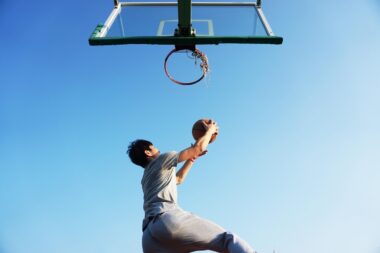Preventing Injuries with Proper Plyometric Techniques for Basketball Players
Plyometrics is essential for basketball players aiming to enhance their performance and reduce injuries. When executed correctly, these exercises can develop explosive strength, improve agility, and enhance overall athleticism. However, poor technique can lead to injuries, undermining these benefits. Concerns arise from improper landing mechanics, which can cause chronic problems over time. Observing proper plyometric techniques is crucial for safe execution. Key factors include maintaining a strong core, using appropriate footwear, and practicing on stable surfaces. Athletes should focus on warm-up routines that prepare the body for such intensive exercises. Moreover, understanding individual limitations is vital; not everyone can perform high-intensity plyometric work without at least some foundational strength training. It is important for coaches and trainers to tailor programs specific to each player while educating them about the risks of inadequate preparation. This understanding can lead to more resilient players who can perform high-impact movements with confidence. Plyometric exercise is ultimately a powerful ally in a basketball player’s training regime, but it is crucial to prioritize safety. Effective planning can mitigate risks significantly.
Understanding the Basics of Plyometrics
Plyometric exercises incorporate explosive movements, aimed at maximizing power output. Ideal for basketball players, they enhance vertical jumps, sprinting, and overall speed. However, an understanding of how to execute these exercises properly is key to preventing injuries. A primary component includes the stretch-shortening cycle, wherein muscles are rapidly lengthened before contraction. When done right, this natural springing motion increases propulsion. To build proficiency, athletes should start with foundational strength training to develop the necessary muscle groups. Exercises such as squats and lunges can condition the muscles, allowing safe plyometric execution later. Furthermore, it’s important to gradually increase intensity, starting with lower-impact exercises like box jumps or hurdle hops. Incorporating variety keeps athletes engaged while fostering better overall coordination. Each exercise should be monitored and adjusted based on an athlete’s performance and comfort level. Progress and feedback are essential for reducing injury risks while maximizing improvements in performance. Coaches must cultivate an environment encouraging communication, where players feel comfortable discussing any discomfort or concerns during plyometric training. This collaboration facilitates safer, more effective plyometric training practices.”
Additional key aspects of plyometrics include focusing on landing techniques to prevent injuries, particularly in basketball. Athletes should aim to land softly and absorb the impact rather than stiffly hit the ground. Proper knee and ankle alignment while landing minimizes excess strain on these joints. Queries into common injuries, such as ankle sprains and knee injuries, arise often; these typically occur due to incorrect landing mechanics. Consequently, educating players on how to utilize proper techniques is imperative. Strengthening surrounding muscles, such as those in the calves and thighs, enhances stability and reduces risks, especially during high-impact activities. Additionally, developing proprioception—the ability to sense body position—can improve balance and coordination. Activities like balance boards and single-leg exercises can significantly promote this. Players must understand their limits to engage in gradual plyometric training progression, which lowers injury risks. A critical approach involves recognizing when fatigue sets in and modifying exercises accordingly; knowing one’s body is essential for protecting against injuries. Thus, well-structured plyometric training, founded on foundational strength, safe landing practices, and mental awareness, ultimately fosters not only improved performance but injury-free athleticism.”
Rest and Recovery Practices
Plyometric exercises are physically demanding, demanding adequate recovery to prevent injuries. Overtraining can lead to fatigue, impairing both performance and safety. Therefore, incorporating rest days into a training regimen is essential. Periodized training, which includes phases of intensity and rest, allows the body to adapt and rebuild stronger. Emphasizing nutrition is also vital because proper fueling aids in recovery. Players should consume a balanced diet that supports muscle recovery post-exercise. Hydration requirements must not be overlooked as well; it substantially affects muscle function and recovery times. Moreover, active recovery methods, including stretching and yoga, assist in maintaining flexibility and reducing muscle soreness. A focus on sleep quality cannot be neglected either; restorative sleep allows the body to recover more efficiently. Including recovery techniques such as foam rolling may also promote muscle repair. Coaches and trainers should develop comprehensive plans that prioritize rest and recovery individually to elicit optimal performance without causing injuries. By understanding the importance of rest, players can train harder and safer while improving their skills, making it an integral aspect of any plyometric-based training program.
In addition to these practices, monitoring the physical state of athletes becomes crucial in preventing injuries. Utilizing technology such as heart rate monitors and wearable devices offers valuable insights for trainers. They can analyze an athlete’s performance and recovery patterns over time to ensure they are not over-exerting themselves. Regular assessments enable coaches to make adjustments when necessary for each player based on their specific needs, optimizing training effectiveness. Furthermore, involving sports scouts and physical therapists can help develop an appropriate plyometric workload. They can provide additional perspectives on injury prevention, incorporating valuable rehabilitation techniques into regular training. Maintaining an open line of communication fosters a supportive environment where injuries can be addressed promptly. Engaging players in discussions about their health and well-being ensures they are aware of their limitations. By keeping lines of communication open, athletes are empowered to take charge of their training while actively focusing on injury prevention. Prioritizing player health leads to a robust relationship between performance enhancement and injury reduction, creating a sustainable environment for cultivating athletic excellence.”
Conclusion of Plyometrics for Basketball
Understanding and implementing proper plyometric techniques are fundamental for basketball players who wish to excel while minimizing injury risks. With sufficient groundwork, athletes can adopt explosive, powerful movements, a necessity in competitive basketball. Emphasizing education on safe practices, proper mechanics, and recovery methods significantly decreases chances of injury. Trainers must keep abreast of the latest research and trends to ensure they are providing optimal training. Creating a culture of safety within the program encourages players to be more open about their experiences. As athletes learn about their bodies and the importance of proper plyometric techniques, they also become more adept at recognizing signs of stress or fatigue leading to injury. Ultimately, focusing on safe practice, proper execution, and proactive recovery will improve not only athlete performance but will also enhance overall team success. As players become more proficient in plyometric exercises, they develop confidence on the court, leading to better gameplay and teamwork. Therefore, this topic warrants constant attention, evolving practices as research advances. As we continue exploring ways to enhance athletic performance in basketball, plyometric training remains a cornerstone topic to ensure player safety concurrently.
In conclusion, plyometric techniques are a vital component in the athletic training of basketball players. When integrated properly into a training program, they can lead to improved performance and decreased injury rates. Coaches, athletes, and trainers should prioritize learning and adapting best practices, thus enabling a safe training environment. Consistent communication, regular assessments, and individualized training plans are key strategies for ensuring players are not only performing at their best but also staying healthy. Examining fundamentals, recovery techniques, and the importance of proper execution elucidates the pathway to safer plyometric training. With an emphasis on these aspects, players can potentiate benefits in explosive movements that translate directly to their performance on the basketball court. Engaging with sportscasters and researching current trends are essential in remaining informed about best practices. By anticipating player needs while addressing risks, teams will foster athletic growth without sacrificing health. Keeping educational resources readily available ensures that athletes know injury prevention strategies. Educational guidance promotes a culture centered on safety and self-awareness within training environments. Ultimately, prioritizing plyometric techniques responsibly can transform both the individual player and the team as a whole.





